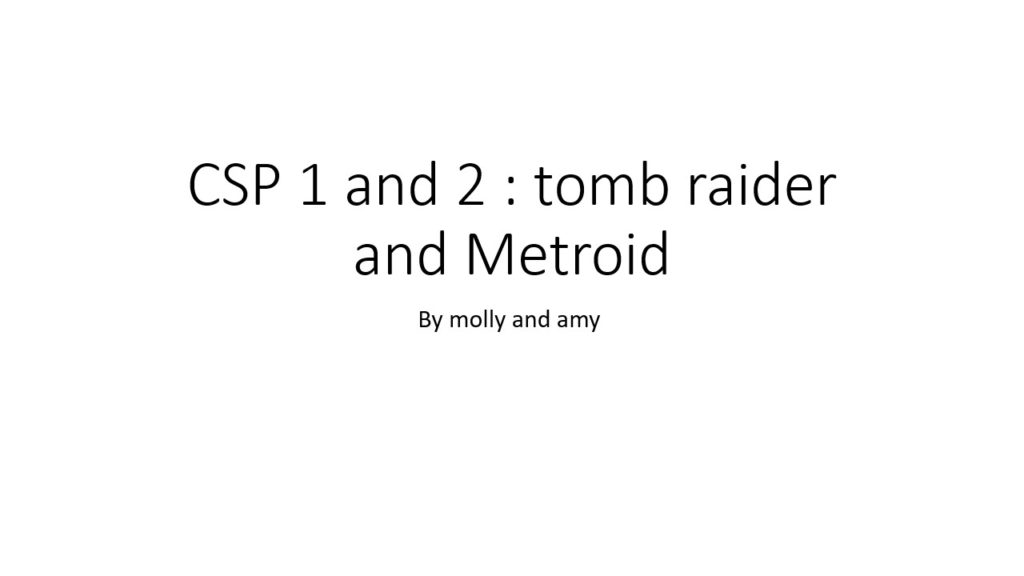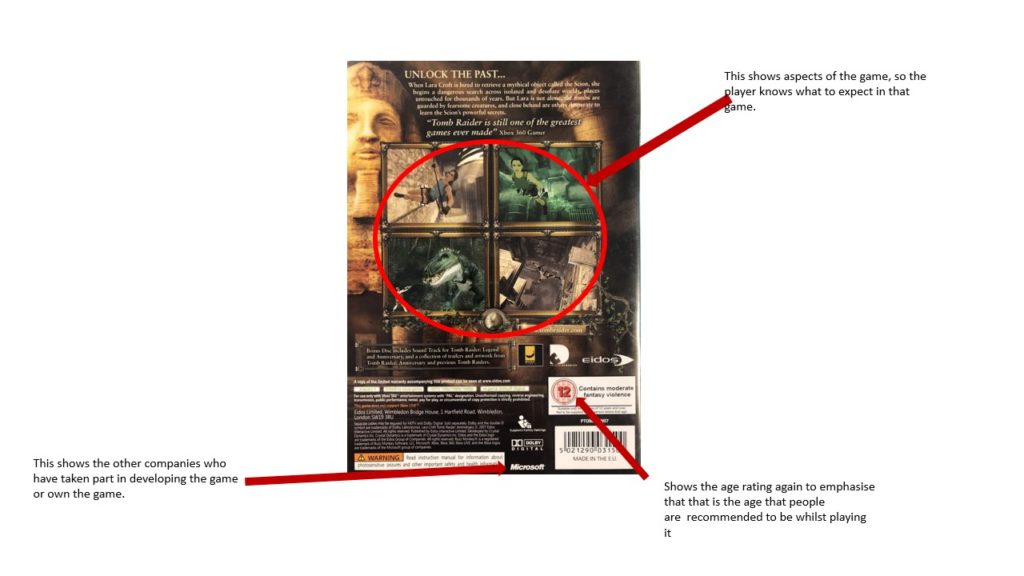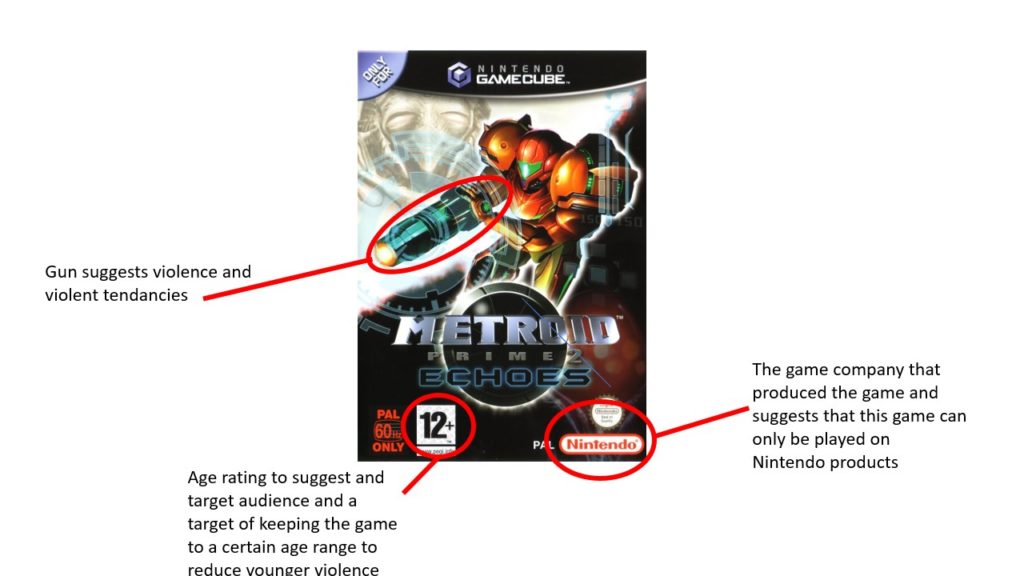In this essay, I am going to apply a semiotic analysis to both the Tomb Raider and Metroid video game covers and discuss them in detail. I will argue that the Tomb Raider game cover is both derogatory and unrealistic, and does not represent femininity in a positive or productive light for both the gaming community and the wider world. On the other hand, I will make it clear that the Metroid game cover could be described in a different, more positive way which may present a more productive representation of the dominant signifier in comparison.
Firstly, the Tomb Raider games cover could be said to give a negative and sexualised representation of femininity. One reason for this is the fact that the dominant signifier, Lara Croft, is shown to have massively exaggerated bodily features, which would never be found in the real world. This reactionary design choice gives connotations of voyeurism and ties into Laura Mulvey’s concept of “The Male Gaze” which is a masculine, heterosexual viewpoint from the stereotypical straight male. It portrays women as “objects” used for sexual pleasure and was first applied by John Berger in a documentary-style analysis named “Ways of Seeing” in 1972. This representation of the character reinforces the idea of the objectification of women, and it makes impressions on the wider gaming community who may begin to treat this viewpoint as the common standard. Because of this, the sexualisation of women may have a chance of becoming the dominant ideology if this manner of representation keeps up, which in my opinion is a bad thing as I don’t see the sexualisation of women as a particularly positive idea. This design choice links to a quote from the article “Why diversity matters in the modern video games industry” – “If you do not see yourself on Netflix, on Instagram, in games, in forums, where are you?” (The Guardian). This implies that “otherworldly” characters with too good to be true bodies are becoming increasingly relevant as society is progressing and their influence across the world is rapidly increasing as well, particularly because of the rise in use of the internet and social media platforms.
In addition, the Tomb Raider games cover may not present femininity in a positive light in other ways. For example, the dominant signifier is holding multiple guns which are in full view for anyone to see. The fact that the game only has an age rating of 12 (assuming the age ratings are even followed or taken remotely seriously at all) means that the stereotypical young male video game players, a rather impressionable demographic, are fully exposed to the usage of guns. This may create a constructed reality in that the players may form mental beliefs about how society should interact based on what they have experienced in the game as they mature as people, and their fluidity of identity develops. This representation of society may not entirely be one shown in a particularly good light, because in my opinion, a confrontational, aggressive and provocative mindset which promotes violence is not one that people should aspire to have.
Furthermore, the Metroid game cover could be said to be presenting femininity in a more positive, productive way. At first glance, this may not appear obvious because the iconic sign of the main character is dressed in a suit which does not clearly show that they are male or female. Because of this, the audience positioning may mean that most of the consumers of the product instantly assume the character to be male, because of the myth that males should be more involved in violent or physical activities, particularly in video games. Upon researching about Metroid, I found that the character in the suit, Samus, is in fact female, which may come as a surprise to many. This idea is a positive countertype to present a radical and challenging representation which could help gamers to adopt a new ways of thinking about gender representation, with more positive role models for young people to aspire to. This also opposes the long-standing conventional concept of the “damsel in distress” and presents an alternative viewpoint to the quote “There is pleasure in being looked at” from Laura Mulvey’s academic paper.
On the other hand, one could argue that the Tomb Raider game cover is a radical, positive take on femininity. One reason for this is the idea that Lara Croft, the main character of the game, is female, which goes against the stereotypical idea that women play the role of “damsels in distress” for male characters to save as described by Anita Sarkeesian of Feminist Frequency. This could have the effect of empowering girls because Lara Croft looks strong, powerful and adventurous on the cover, and this shows that women are more than capable of defending themselves and do not depend on men to do these jobs for them. The quote “As a girl growing up playing games I was always like, why do I have to play as a boy?” (The Guardian) ties into this in that men are commonly seen as the more dominant and powerful figureheads in society, and this hegemony has rapidly spread into video games too, which is a key reason as to why this aspect of the game cover stands out to me.
However, the Metroid game cover could be presenting femininity in a negative light. One reason for this is the fact that the dominant signifier (who is in fact female) is dressing up in a way which does not make her gender very apparent. This may imply that females need to “dress up” to seem as powerful or capable as males. An idea which may tie into this is the audience positioning, and from a business perspective the intent to make the character not immediately depict a female may be to attract more sales, as video games have progressed to the point where males taking on critical roles as opposed to females has become the modern standard, and gamers may not be always willing to break the mold and buy radical products. This is a negative representation in my opinion because it shows that there is still a long way to go before true equality between male and female roles in society can be reached, and the world still remains rather patriarchal in this aspect.
To conclude, both the Tomb Raider and Metroid game covers give representations of femininity which can be interpreted in many opposing ways. The Tomb Raider cover could provide a negative representation of femininity because of the blatant sexualisation of the main character, which satisfies stereotypical young, male video game players. The Metroid game cover could give a similar negative representation in that the main character is not shown in a manner that depicts her true gender identity (female). This may be because of the myth that females are not as capable of accomplishing bold feats as males, and so consequently the hegemony of men is reinforced. Alternatively, you could say that the Tomb Raider game cover presents femininity in a positive manner because of the fact that the female character of Lara Croft is shown to be the main protagonist of the game. This shows us that females are capable of much more than merely existing to be looked at, and being saved for dramatic effect. One could also think that the Metroid Games Cover presents a positive take on femininity because of the fact that the character who is dressed in combat gear with clear intent on carrying out strenuous activities is female. This indicates that the games cover is a radical portrayal of females which shows that they are indeed capable of fending for themselves, and it counteracts the popular concept of the “damsel in distress”. Taken together, I believe that all of the arguments presented in this essay have reasonable strength, however personally I believe that the Tomb Raider games cover has more of a negative representation of femininity, particularly because of the way that it conveys connotations and ideas of sexualisation and violence which are becoming ever prevalent in modern society. On the other hand, I think that the Metroid game cover shows an alternate, positive perspective on femininity, in that the main female character is shown as powerful, independent and confident, which is a positive countertype to present a radical and challenging representation which could help gamers to adopt new ways of thinking about gender representation. This could lead to people challenging the dominant ideology of males being more powerful and influential in society than females for themselves, which (for me) is an idea that has the potential to be very beneficial in the growth and development of society in the future.





